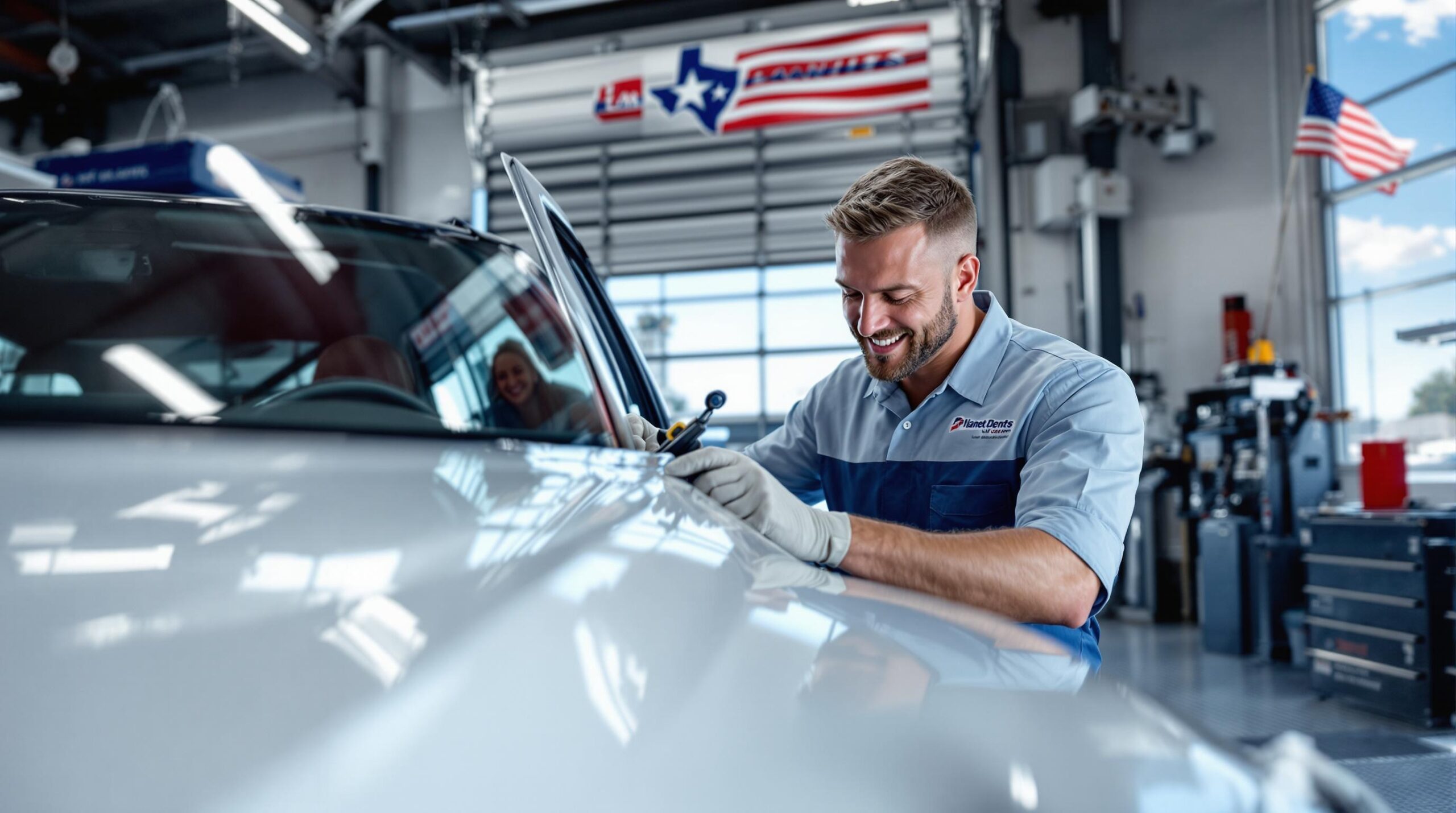Central Texas Storms & Scorchers: How to Protect Your Vehicle from Hail Damage and Triple-Digit Heat This Summer
Estimated reading time: 6 minutes
- Understanding the combined effects of hail damage and summer heat on vehicles.
- Importance of immediate assessment and repairs after hailstorms.
- Comprehensive step-by-step guide for protecting your vehicle.
- How Planet Dents offers solutions to prevent heat-related deterioration.
- Resources for free assessments and damage evaluations.
Table of Contents
- Why Central Texas Hail Damage Becomes Catastrophic in Summer Heat
- How Planet Dents Solves Complete Storm and Heat Damage for Central Texas Drivers
- Your Step-by-Step Experience with Planet Dents
- FAQ
Why Central Texas Hail Damage Becomes Catastrophic in Summer Heat
The unique climate challenges of Central Texas hail damage and summer car protection create a devastating combination that most vehicle owners severely underestimate. While drivers often focus solely on the visible dents from hailstorms, the real destruction frequently occurs in the weeks following the storm when triple-digit temperatures transform minor damage into major catastrophes.
Here’s the science behind this destructive process: hail impacts create microscopic fractures in your vehicle’s paint and protective coatings, even when the dents themselves appear minor. These tiny compromises in your car’s protective barrier become entry points for heat, UV radiation, and moisture during Central Texas summers. When temperatures climb above 100°F – which happens regularly from June through September – the metal underneath these compromised areas expands and contracts rapidly, causing paint to bubble, peel, and separate from the metal surface.
The thermal expansion is particularly brutal on darker vehicles. A black car parked in direct sunlight can reach surface temperatures exceeding 180°F, literally cooking the compromised areas where hail damage occurred. This extreme heat causes adhesion failure between paint layers, leading to blistering and peeling that spreads far beyond the original impact points. What started as minor dents becomes a complete paint system failure requiring full panel repainting instead of simple paintless dent repair.
Central Texas weather patterns make this problem even worse. Our region experiences some of the most severe temperature swings in the country – from hail-producing storms in the 60s and 70s to scorching 105°F days within hours. This rapid cycling between extreme temperatures puts tremendous stress on already-compromised paint and metal, accelerating the deterioration process exponentially.
Insurance companies understand this destructive timeline, which is why they encourage immediate assessment and repairs after hailstorms. Waiting even a few weeks during summer months can transform a covered hail damage claim into a much more expensive heat damage situation that may not be fully covered. The key is understanding that hail damage assessment must account for both immediate visible damage and the inevitable heat-related deterioration that follows in our climate.
How Planet Dents Solves Complete Storm and Heat Damage for Central Texas Drivers
At Planet Dents, we’ve developed a comprehensive approach to Central Texas hail damage and summer car protection that addresses both immediate storm damage and prevents costly heat-related deterioration. Our 25+ years serving families from Austin to San Antonio has taught us that effective hail repair must account for the unique challenges of our scorching summers.
Our advanced Paintless Dent Repair (PDR) methodology goes far beyond simply removing dents. We begin every assessment by examining the paint integrity around each impact point using specialized lighting and magnification tools. This allows us to identify microscopic compromises in the protective coating that could lead to heat damage later. When we find these vulnerabilities, we apply protective sealants and treatments that restore the paint’s barrier properties, preventing the thermal expansion damage that destroys so many vehicles during Central Texas summers.
The process starts with our certified technicians using industry-leading GPR (Glue Pull Repair) systems and traditional PDR tools to restore the metal to its original contour without affecting the factory paint finish. But here’s what sets Planet Dents apart: we don’t stop there. Once the dents are removed, we perform a comprehensive paint protection analysis using thermal imaging to identify areas where the protective coating may have been compromised by hail impacts.
Take our recent customer from Round Rock who came to us after the early June hailstorm. Sarah’s black Honda Accord had suffered severe roof and hood dents, but she initially planned to wait a few weeks before getting repairs. Fortunately, she called us first for an assessment. During our inspection, we discovered not only the obvious dent damage but also noted that her vehicle had been parked at the Old Settler’s Music Festival during the peak heat following the storm. The combination of hail damage and prolonged exposure to festival parking lot conditions had already begun causing paint blistering around the impact points.
Our team immediately implemented our emergency heat damage prevention protocol, applying specialized protective coatings to the compromised areas while we completed the PDR work. We also advised Sarah on proactive parking strategies and paint protection measures to prevent similar damage during future summer events. The result? What could have been a $4,000 paint job became a $1,200 PDR repair with lifetime warranty protection.
This comprehensive approach is why we’ve maintained partnerships with every major insurance company in Texas. They know that Planet Dents doesn’t just fix the immediate problem – we prevent the expensive secondary damage that can occur when hail repairs aren’t done properly or promptly. Our family business reputation depends on delivering complete solutions that protect our customers’ investments for years to come.
Want to see how this comprehensive approach works for your situation? Get a free assessment that includes both damage evaluation and heat protection recommendations.
Your Step-by-Step Experience with Planet Dents
When you choose Planet Dents for your hail damage repair, you’re getting a streamlined process designed specifically for Central Texas drivers dealing with storm damage and summer heat concerns. Our systematic approach ensures no detail is overlooked while minimizing disruption to your daily routine.
Initial Contact and Emergency Assessment (Day 1)
Your experience begins with a single phone call to our Round Rock facility. Our family-owned business prioritizes immediate response during storm seasons because we understand how quickly heat damage can compound hail damage in Central Texas. We’ll schedule your comprehensive assessment within 24-48 hours, or provide emergency mobile assessment if your vehicle shows signs of rapidly deteriorating paint integrity.
Comprehensive Damage Documentation (Days 1-2)
Our certified technicians perform a thorough inspection using specialized lighting and digital documentation tools. This isn’t just counting dents – we’re mapping every impact point, measuring depth and diameter, and most importantly, checking paint integrity around each damage area. We photograph everything with high-resolution cameras and create detailed damage reports that insurance companies trust and accept without question.
Insurance Coordination and Approval (Days 2-5)
Here’s where Planet Dents really shines. We handle 100% of your insurance communication, paperwork, and negotiation. Our established relationships with all major carriers mean faster approvals and fair settlements. We know exactly how to document heat vulnerability in hail damage reports, ensuring your claim covers both immediate repairs and prevention of future thermal damage. Most customers are approved within 3-5 business days.
Repair Scheduling and Vehicle Preparation (Day 5-7)
Once approved, we coordinate your rental car through our preferred partners and schedule your repair during the optimal time frame. For vehicles with heat-sensitive damage, we prioritize scheduling during cooler morning hours when possible. We’ll also apply temporary protective treatments if there’s any delay, ensuring your vehicle doesn’t suffer additional deterioration while waiting for repairs.
Professional PDR and Protection Application (Days 7-10)
The actual repair process typically takes 2-4 days, depending on damage extent. Our climate-controlled facility protects your vehicle from temperature extremes during repairs. We use advanced PDR techniques to restore every dent, then apply our proprietary heat-protection treatments to vulnerable areas. Each repair comes with detailed before/after documentation and warranty information.
Final Inspection and Customer Education (Day 10)
Before returning your vehicle, we conduct a comprehensive final inspection and provide personalized education about summer vehicle protection. You’ll receive specific recommendations for parking strategies, protective products, and maintenance schedules tailored to Central Texas climate challenges. We also provide our emergency contact information for any future concerns.
The entire process typically completes within 10 business days from initial contact to vehicle return, with most of that time devoted to insurance coordination rather than actual repairs. We maintain constant communication throughout, so you’re never wondering.
FAQ
- How do I know if my vehicle has hail damage?
- What is Paintless Dent Repair?
- Should I file an insurance claim for hail damage?
- How long will repairs take?
How do I know if my vehicle has hail damage?
Hail damage can range from minor dents to severe impacts that crack paint. A visual inspection after a storm can help, but a professional assessment is best for comprehensive evaluation.
What is Paintless Dent Repair?
Paintless Dent Repair (PDR) is a method that uses specialized tools to remove dents without damaging the vehicle’s finish.
Should I file an insurance claim for hail damage?
It’s advisable to file a claim as soon as possible to ensure coverage for repairs before additional heat damage exacerbates the situation.
How long will repairs take?
The repair process typically takes about 10 business days from initial assessment to vehicle return, depending on insurance coordination.


